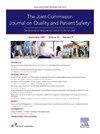A Systems-Based Framework for Integrating Health Equity and Patient Safety
IF 2.4
Q2 HEALTH CARE SCIENCES & SERVICES
Joint Commission journal on quality and patient safety
Pub Date : 2025-07-01
DOI:10.1016/j.jcjq.2025.04.005
引用次数: 0
Abstract
Research is needed to better understand inequities in patient safety, to develop interventions to improve safety and equity together, and to measure the efficacy of such interventions. Although measures of disparities in health outcomes, health care access, and quality of care are common, patient safety equity measurement remains underdeveloped. For example, disparities have often been documented in chronic diseases or access to preventive care but are less frequently studied for adverse drug events or postoperative complications. Patients of minority backgrounds experience higher rates of preventable harm—Black patients face increased risk of hospital-acquired infections and medication errors compared to white patients, yet most health systems lack specific tools to systematically measure and address these safety disparities. Based on a literature review and expert panel conducted between January 2023 and December 2023, the authors identified health system–level measures of equity in patient safety and present a preliminary maturity framework for health systems working toward equity in patient safety. This review found several tools for measuring health disparities and health equity more broadly, but few are specifically designed to evaluate equity in patient safety events and processes. To address this critical gap, the authors leveraged feedback from a panel of eight subject matter experts to develop a preliminary framework designed to support health systems in assessing their maturity levels and integrating equity in patient safety in a stepwise manner. The framework consists of three maturity levels (fundamental, intermediate, advanced) and six domains: (1) data collection and training, (2) data validation, (3) data stratification and analysis, (4) communicating findings, (5) addressing and resolving equity gaps in patient safety, and (6) organizational infrastructure and culture.
整合卫生公平和患者安全的系统框架。
需要进行研究,以更好地了解患者安全方面的不公平现象,制定干预措施以共同改善安全性和公平性,并衡量此类干预措施的效力。虽然衡量健康结果、卫生保健可及性和护理质量方面的差异的措施很常见,但患者安全公平的措施仍然不发达。例如,在慢性病或获得预防性保健方面的差异经常有记录,但对药物不良事件或术后并发症的研究较少。少数族裔背景的患者经历了更高的可预防伤害率——与白人患者相比,黑人患者面临着更高的医院获得性感染和用药错误的风险,然而大多数卫生系统缺乏具体的工具来系统地衡量和解决这些安全差异。根据2023年1月至2023年12月期间进行的文献综述和专家小组,作者确定了卫生系统层面的患者安全公平措施,并提出了卫生系统致力于患者安全公平的初步成熟度框架。本综述发现了一些更广泛地衡量健康差异和健康公平的工具,但很少有专门设计用于评估患者安全事件和过程中的公平。为了解决这一重大差距,作者利用由8名主题专家组成的小组的反馈,制定了一个初步框架,旨在支持卫生系统评估其成熟度水平,并逐步将公平纳入患者安全。该框架包括三个成熟度级别(基础、中级、高级)和六个领域:(1)数据收集和培训,(2)数据验证,(3)数据分层和分析,(4)沟通发现,(5)处理和解决患者安全方面的公平差距,以及(6)组织基础设施和文化。
本文章由计算机程序翻译,如有差异,请以英文原文为准。
求助全文
约1分钟内获得全文
求助全文
来源期刊

Joint Commission journal on quality and patient safety
HEALTH CARE SCIENCES & SERVICES-
CiteScore
3.80
自引率
4.30%
发文量
116
审稿时长
49 days
 求助内容:
求助内容: 应助结果提醒方式:
应助结果提醒方式:


